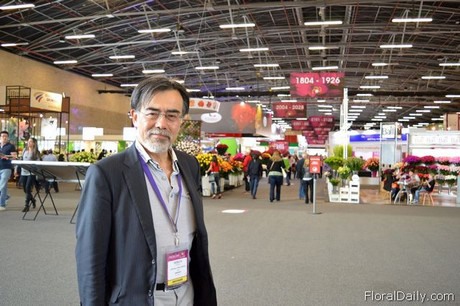
Nobuya Kaishita of Chrysal and JMFA visited the Proflora in Bogota, Colombia.
Decrease production area
From 1999 to 2011, the total production area in Japan decreased by 20%, from 19,700 ha in 1999 to 15,770 ha in 2011. This decrease was the case for all domestically produced cut flowers measured. Despite a decrease of 20 percent, the production area of the chrysanthemum is still the largest; 5.233 ha, followed by the production area of the lily, lisianthus, rose, carnation, gypsophila, statice, and alstroemeria. The decline in production area of the gypsophila was the largest; minus 40 percent, from 424 ha in 1999 to 253 ha in 2011. Below, the entire overview of the cut flower production area in Japan is shown, from 1999 to 2011.

Cut flower production area Japan, from 1999 to 2011.
Import market share: 15%
In 2012, the import market share was 15%. According to Kaishita, Japan demands 6.0 billion stems on a yearly basis. "The demand for the chrysanthemums is the highest, around 36 percent, followed by other flowers, carnations, roses and lilies. The majority of all these flowers are domestically produced. However, increasingly more flowers are being imported. A large percentage of the carnations are being imported, around 46 percent, followed by roses (22%), spray chrysanthemums (14%) and lilies (8%)."
Main import countries: Malaysia, Colombia and China
Over the years, the number of imported flowers has increased steadily and reached an imported value of 441.7 million USD in 2012. In 1996, the majority of the flowers were still imported from the Netherlands, followed by Thailand, Colombia and Malaysia. In recent years, the number of imported flowers from these latter two countries increased sharply. Now, they are the two main countries that supply flowers to Japan, followed by China, which started to supply mainly chrysanthemums and carnations in 2004. Malaysia mainly supplies spray chrysanthemums and Colombia, roses and carnations.
Future
According to Kaishita, the production will decline further in the coming years. "In 12 years, we expect a large decrease in the cut flower production. The younger generation, who inherit the land, do not take over the business or sell the land. Consequently, no land will become available for other growers to expand or start a new business." An increase in imports seems to be a logical consequence. However, Kaishita is not sure about that. "Over the last two years, the imports stabilized due to the devaluation of the Japanese yen. Moreover, we also notice a decrease in demand for flowers. The younger generation does not attach that much value to flowers and therefore, do not buy them as much as the older generation. It is the reason why we, from JFMA and Flowering Japan Council, are working hard on the promotion of flowers. We hope we can create Japanese life style with flowers for the future development of the floral market and floral demand," he concludes.
For more information
Japan Floral Marketing Association
Chrysal Japan Limited
Nobuya Kaishita
Email: kaishitacj@aol.com
mpsjapan-blog.jugem.jp
